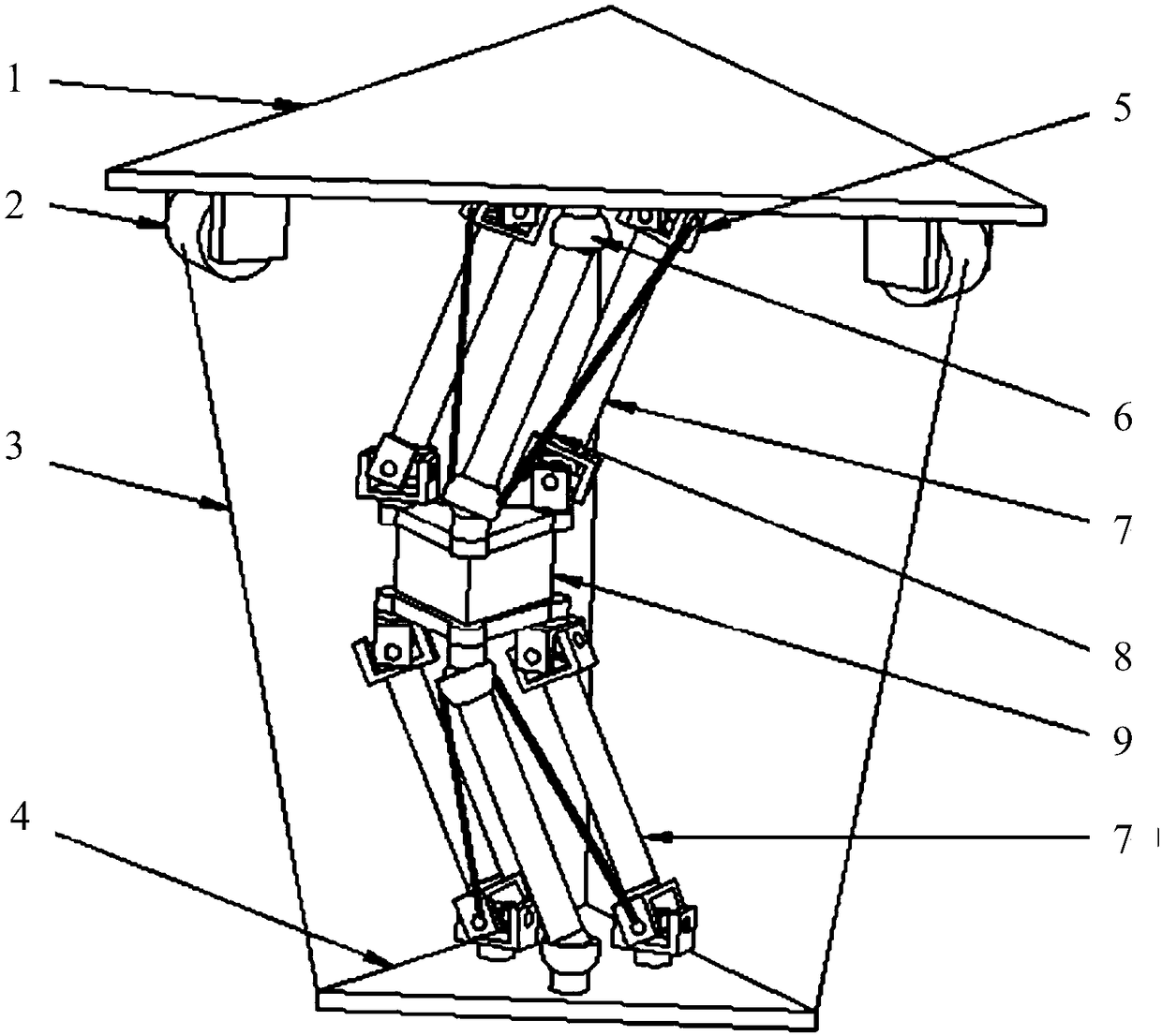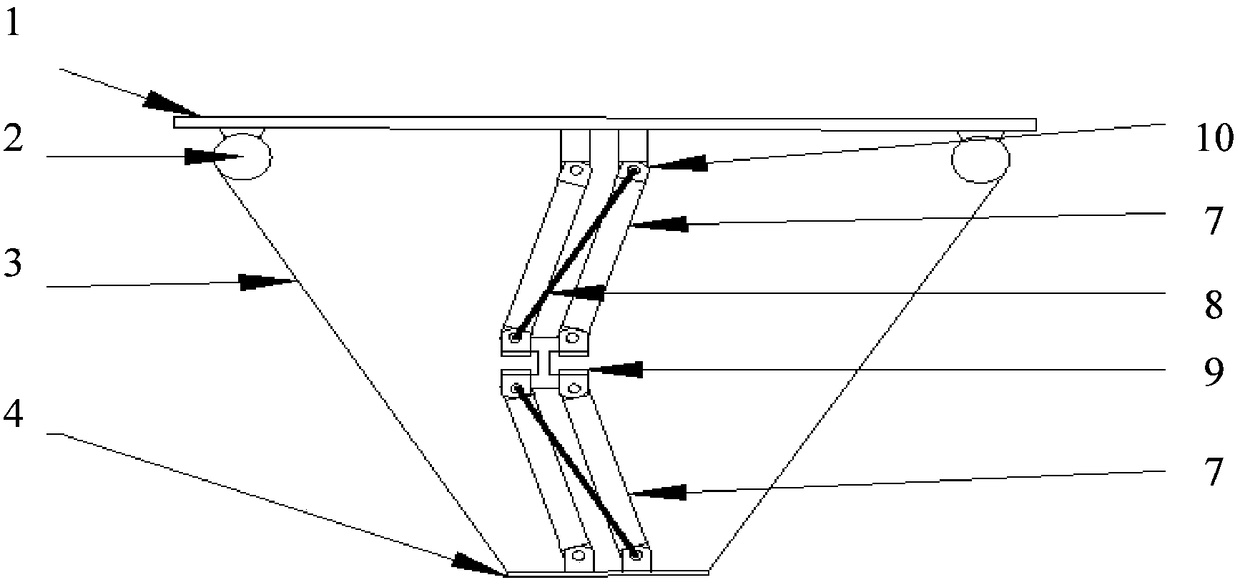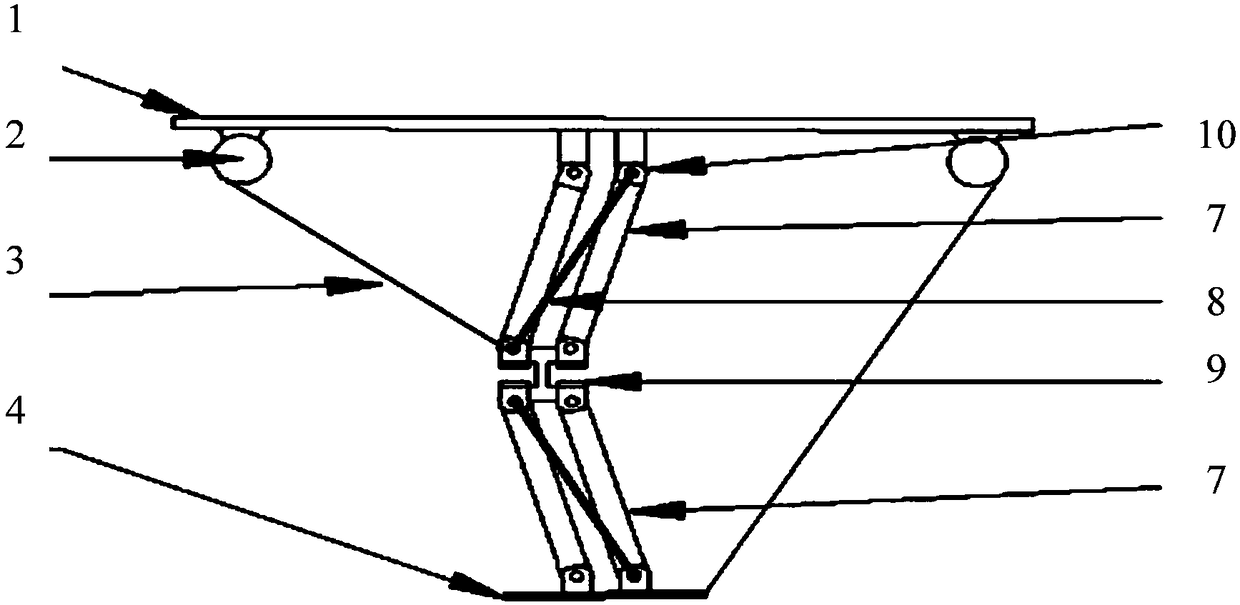A cable parallel device based on translational restraint structure
A technology of restraint structure and translation, applied in the direction of program control manipulators, manufacturing tools, manipulators, etc., can solve the problems of pushing up the manufacturing cost and system complexity, limiting the configuration of the cable-parallel mechanism, increasing the number of driving cables, etc. Manufacturing cost and control complexity, avoidance of attitude errors, effect of reducing redundant control requirements
- Summary
- Abstract
- Description
- Claims
- Application Information
AI Technical Summary
Problems solved by technology
Method used
Image
Examples
Embodiment 1
[0036] like figure 1 As shown, the space three-translation cable parallel mechanism based on the translation constraint structure consists of a static platform 1, a drum and a driving unit 2, a rope 3, a moving platform 4, a Hooke hinge 5, a ball hinge 6, a rigid rod 7, a spring 8, Intermediate platform 9 constitutes;
[0037] One end of the two rigid rods 7 is connected to the static platform 1 through the Hooke hinge 5, and the other end is connected to the intermediate platform 9 through the Hooke hinge 5, ensuring that the rotation axes of the four Hooke hinges 5 are parallel and the rigid rods 7 are parallel, forming a parallel structure. quadrilateral body. Outside the parallelogram plane, one end of the third rigid rod 7 is connected to the static platform 1 through the ball joint 6, and the other end is connected to the intermediate platform 9 through the ball joint 6, and the three rods 7 are parallel and equal to each other in the initial state. long. At this time...
Embodiment 2
[0040] like figure 2As shown, the parallel mechanism of two translational cables based on the translational restraint structure is composed of a static platform 1, a drum and a driving unit 2, a rope 3, a moving platform 4, a rotary hinge 10, a rigid rod 7, a spring 8, and an intermediate platform 9 ;
[0041] One end of the two rigid rods 7 is connected to the static platform 1 through a rotary hinge 10, and the other end is connected to the intermediate platform 9 through a rotary hinge 10 to ensure that the rotation axes of the four rotary hinges 10 are parallel to each other and the rigid rods 7 are equal in length and parallel to form a parallel structure. quadrilateral body. At this time, it can be guaranteed that the intermediate platform 9 and the static platform 1 are always parallel. Similarly, the rotary hinge 10 and the rigid rod 7 are used to connect the moving platform 4 and the intermediate platform 9 to form a planar translation constraint structure to ensur...
Embodiment 3
[0044] like image 3 As shown, the parallel mechanism of two translational cables based on the translational restraint structure is composed of a static platform 1, a drum and a driving unit 2, a rope 3, a moving platform 4, a rotary hinge 10, a rigid rod 7, a spring 8, and an intermediate platform 9 ;
[0045] One end of the two rigid rods 7 is connected to the static platform 1 through a rotary hinge 10, and the other end is connected to the intermediate platform 9 through a rotary hinge 10 to ensure that the rotation axes of the four rotary hinges 10 are parallel to each other and the rigid rods 7 are equal in length and parallel to form a parallel structure. quadrilateral body. At this time, it can be guaranteed that the intermediate platform 9 and the static platform 1 are always parallel. Similarly, the rotary hinge 10 and the rigid rod 7 are used to connect the moving platform 4 and the intermediate platform 9 to form a planar translation constraint structure to ensur...
PUM
 Login to View More
Login to View More Abstract
Description
Claims
Application Information
 Login to View More
Login to View More - R&D
- Intellectual Property
- Life Sciences
- Materials
- Tech Scout
- Unparalleled Data Quality
- Higher Quality Content
- 60% Fewer Hallucinations
Browse by: Latest US Patents, China's latest patents, Technical Efficacy Thesaurus, Application Domain, Technology Topic, Popular Technical Reports.
© 2025 PatSnap. All rights reserved.Legal|Privacy policy|Modern Slavery Act Transparency Statement|Sitemap|About US| Contact US: help@patsnap.com



